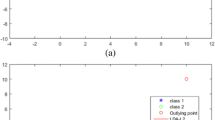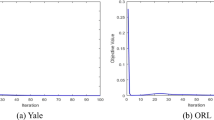Abstract
Linear discriminant analysis (LDA) is a well-known supervised method that can perform dimensionality reduction and feature extraction effectively. However, traditional LDA-based methods need to be turned into the trace ratio form to compute the closed-form solution, in which the within-class scatter matrix should be nonsingular. In this article, we design a new model named generalized robust linear discriminant analysis (GRLDA) method to tackle this disadvantage and improve the robustness. GRLDA uses \({L}_{\mathrm{2,1}}\)-norm on both loss functions to reduce the influence of outliers and on regularization term to obtain joint sparsity simultaneously. The intrinsic graph and the penalty graph are constructed to characterize the intraclass similarity and interclass separability, respectively. A novel optimization method is proposed to solve the proposed model, in which a quadratic problem on the Stiefel manifold is involved to avoid the inverse computation on a singular matrix. We also analyze the computational complexity rigorously. Finally, the experimental results on face, object, and medical images exhibit the superiority of GRLDA.







Similar content being viewed by others
Explore related subjects
Discover the latest articles, news and stories from top researchers in related subjects.Data availability
The datasets analyzed during the current study are available in the following databases.
(1) COIL20 database (http://www.cs.columbia.edu/CAVE/software/softlib/coil-20.php),
(2) FERET database (http://www.nist.gov/itl/iad/ig/colorferet.cfm),
(3) ORL database (http://www.uk.research.att.com/facedatabase.html),
(4) AR database (http://www2.ece.ohio-state.edu/~aleix/ARdatabase.html).
(5) MedMNIST database (https://medmnist.com/).
(6) Extended Yale B Database (https://www.kaggle.com/datasets/tbourton/extyalebcroppedpng).
References
Tao D, Tang X, Li X (2006) Direct kernel biased discriminant analysis: a new content based image retrieval relevance feedback algorithm. IEEE Trans Multimed 8(4):716–727
Passalis N, Tefas A (2018) Dimensionality reduction using similarity-induced embeddings. IEEE Trans Neural Netw Learn Syst 29(8):3429–3441
Vashishtha G, Kumar R (2023) Unsupervised learning model of sparse filtering enhanced using wasserstein distance for intelligent fault diagnosis. J Vib Eng Technol 11(7):2985–3002
Lou Q, Deng Z, Choi K-S, Shen H, Wang J, Wang S (2021) Robust multi-label relief feature selection based on fuzzy margin co-optimization, IEEE Trans Emerg Topics Comput Intell, early access
Vashishtha G, Chauhan S, Kumar A, KumarAn R (2022) Ameliorated African Vulture Optimization Algorithm to Diagnose the Rolling Bearing Defects. Meas Sci Technol 33(7):075013
Lai Z, Xu Y, Jin Z, Zhang D (2014) Human gait recognition via sparse discriminant projection learning. IEEE Trans Circuits Syst Video Technol 24(10):1651–1662
Yang L, Song S, Gong Y (2019) Nonparametric dimension reduction via maximizing pairwise separation probability. IEEE Trans Neural Netw Learn Syst 30(10):3205–3210
Bhadra T, Maulik U (2022) Unsupervised Feature Selection Using Iterative Shrinking and Expansion Algorithm. IEEE Trans Emerg Topics Comput Intell 5(5):1453–1462
Vashishtha G, Kumar R (2022) Feature Selection Based on Gaussian Ant Lion Optimizer for Fault Identification in Centrifugal Pump, Recent Advances in Machines and Mechanisms: Select Proceedings of the iNaCoMM 2021. Singapore: Springer Nature Singapore. 295–310
Cunningham JP, Ghahramani Z (2015) Linear dimensionality reduction: Survey, insights, and generalizations. J Mach Learn Research 16(1):2859–2900
Sumithra V, Surendran S (2015) A review of various linear and non linear dimensionality reduction techniques. Int J Comput Sci Inf Technol 6(3):2354–2360
Kwak N (2008) Principal component analysis based on L1-norm maximization. IEEE Trans Pattern Anal Mach Intell 30(9):1672–1680
Martinez AM, Kak AC (2001) PCA versus LDA. IEEE Trans Pattern Anal Mach Intell 23(2):228–233
He X (2004) Locality preserving projections. Proc Adv Neural Inf Process Syst 16(1):186–197
Roweis ST, Saul LK (2000) Nonlinear dimensionality reduction by locally linear embedding, science, 2000, vol. 290, no. 5500, pp. 2323–2326
Balasubramanian M, Schwartz EL (2002) The isomap algorithm and topological stability. Science 295(5552):7–7
Belkin M, Niyogi P (2003) Laplacian eigenmaps for dimensionality reduction and data representation. Neural Comput 15(6):1373–1396
Wen J, Fang X, Cui J, Fei L, Yan K, Chen Y, Xu Y (2018) Robust sparse linear discriminant analysis. IEEE Trans Circuits Syst Video Technol 29(2):390–403
Wang H, Yan S, Xu D, Tang X, Huang T (2007) Trace ratio vs. ratio trace for dimensionality reduction, in Proc IEEE Comput Soc Conf Comput Vision Pattern Recognit, pp. 1–8
Wang J, Wang L, Nie F, Li X (2021) A novel formulation of trace ratio linear discriminant analysis, IEEE Trans Neural Netw Learn Syst, pp. 1–11
Wang J, Wang H, Nie F, Li X (2022) Ratio sum vs. sum ratio for linear discriminant analysis. IEEE Trans Pattern Anal Mach Intell 44(12):10171–10185
Pang Y, Yuan Y (2010) Outlier-resisting graph embedding. Neurocomputing 73(4–6):968–974
Yan S, Xu D, Zhang B, Zhang H-J, Yang Q, Lin S (2006) Graph embedding and extensions: a general framework for dimensionality reduction. IEEE Trans Pattern Anal Mach Intell 29(1):40–51
Ding C, Zhou D, He X, Zha H (2006) R1-PCA: Rotational invariant L1-norm principal component analysis for robust subspace factorization, Proc 23rd Int Conf Mach Learn: 281–288
Li X, Hu W, Wang H, Zhang Z (2010) Linear discriminant analysis using rotational invariant L1-norm. Neurocomputing 73(13–15):2571–2579
Pang Y, Li X, Yuan Y (2010) Robust tensor analysis with L1-norm. IEEE Trans Circuits Syst Video Technol 20(2):172–178
Zou H, Hastie T, Tibshirani R (2004) Sparse principal component analysis. J Comput Graph Stat 15(2):265–286
Nie F, Wang Z, Wang R, Wang Z, Li X (2019) Towards robust discriminative projections learning via non-greedy L2,1-norm minmax. IEEE Trans Pattern Anal Mach Intell 43(6):2086–2100
Nie F, Yuan J, Huang H (2014) Optimal mean robust principal component analysis, Int Conf Mach Learn, PMLR
Zhao H, Wang Z, Nie F (2019) A new formulation of linear discriminant analysis for robust dimensionality reduction. IEEE Trans Knowl Data Eng 31(4):629–640
Lai Z, Xu Y, Yang J, Shen L, Zhang D (2016) Rotational invariant dimensionality reduction algorithms. IEEE Trans Cybern 47(11):3733–3746
Mo D, Lai Z, Wong WK (2019) Locally joint sparse marginal embedding for feature extraction. IEEE Trans Multimed 21(12):3038–3052
Lin Y, Lai Z, Zhou J, Wen J, Kong H (2023) Multiview Jointly Sparse Discriminant Common Subspace Learning. Pattern Recognit 138:109342
Li Z, Nie F, Wu D, Wang Z, Li X (2023) Sparse Trace Ratio LDA for Supervised Feature Selection, IEEE Trans Cybern, early access. https://doi.org/10.1109/TCYB.2023.3264907
Mo D, Lai Z, Zhou J, Hu Q (2023) Scatter matrix decomposition for jointly sparse learning. Pattern Recognit 140:109485
Nie F, Huang H, Cai X, Ding C (2010) Efficient and robust feature selection via joint L2,1-norms minimization, Proc Adv Neural Inf Process Syst, pp. 1813–1821
Wong WK, Zhao HT (2012) Supervised optimal locality preserving projection. Pattern Recognit 45(1):186–197
Yang Y, Shen HT, Ma Z, Huang Z, Zhou X (2011) L2,1-norm regularized discriminative feature selection for unsupervised, IJCAI Int Joint Conf Artif Intell
Nie F, Wu D, Wang R, Li X (2007) Truncated robust principle component analysis with a general optimization framework. IEEE Trans Pattern Anal Mach Intell 40(1):339–342
Turk M, Pentland A (1991) Eigenfaces for recognition. J Cogn Neurosci 3(1):71–86
Ye J, Xiong T, Madigan D (2006) Computational and theoretical analysis of null space and orthogonal linear discriminant analysis J Machine Learn Res, vol. 7, no. 7
Mo D, Lai Z, Wang X, Wong WK (2019) Jointly sparse locality regression for image feature extraction. IEEE Trans Multimed 22(11):2873–2888
Lai Z, Mo D, Wen J, Shen L, Wong WK (2018) Generalized robust regression for jointly sparse subspace learning. IEEE Trans Circuits Syst Video Technol 29(3):756–772
Wang K, He R, Wang L, Wang W, Tan T (2015) Joint feature selection and subspace learning for cross-modal retrieval. IEEE Trans Pattern Anal Mach Intell 38(10):2010–2023
Huang J, Li G, Huang Q, Wu X (2017) Joint feature selection and classification for multilabel learning. IEEE Trans Cybern 47(3):876–889
Shi X, Yang Y, Guo Z, Lai Z (2014) Face recognition by sparse discriminant analysis via joint L2,1-normminimization. Pattern Recognit 47:2447–2453
Author information
Authors and Affiliations
Contributions
All authors contributed to the study conception and design. Material preparation, data collection and analysis were performed by Yufei Zhu, Zhihui Lai, Can Gao, and Heng Kong. The first draft of the manuscript was written by Yufei Zhu and Zhihui Lai, and all authors commented on previous versions of the manuscript. All authors read and approved the final manuscript.
Corresponding author
Ethics declarations
Competing interests
This work was supported in part by the Natural Science Foundation of China under Grant 62272319, and in part by the Natural Science Foundation of Guangdong Province (Grant 2023A1515010677, 2024A1515011637) and Science and Technology Planning Project of Shenzhen Municipality under Grant JCYJ20210324094413037 and JCYJ20220818095803007.
Ethical and informed consent for data used
I confirm that I have obtained informed consent from all participants whose data I used in my research.
Additional information
Publisher's Note
Springer Nature remains neutral with regard to jurisdictional claims in published maps and institutional affiliations.
Appendices
Appendix
First, we introduce a lemma as follows:
Lemma 3
Assuming that f(x) is a convex function of x where x can be a scalar, vector or matrix variable, then we obtain:
where f'(x2) is the super-gradient of f(x) at x2.
Proof of the theorem 2
It is easy to know that \({\mathrm{f}}_{\mathrm{i}}({\mathrm{h}}_{\mathrm{i}}(\mathrm{m}))\) is an arbitrary convex function w.r.t. \({\mathrm{h}}_{\mathrm{i}}(\mathrm{m})\) under the arbitrary constraint of \(\mathrm{m}\in\Omega\). We assume that \({\mathrm{f}}_{\mathrm{i}}({\mathrm{h}}_{\mathrm{i}}(\mathrm{m}))\le0\). In the t-th iteration, we denote \({\mathrm{G}}_{\mathrm{i}}^{\mathrm{t}}={{\mathrm{f}}{\prime}}_{\mathrm{i}}({\mathrm{h}}_{\mathrm{i}}({\mathrm{m}}^{\mathrm{t}-1}))\). For each i, according to the lemma 3, we have:
According to (21), the following can be derived:
Summing (29) and (30), we have:
Summing (31) and \({\mathrm{f}}_{\mathrm{i}}({\mathrm{h}}_{\mathrm{i}}(\mathrm{m}))\le 0\), the value of the objective function (16) will monotonically increase until convergence.
Rights and permissions
Springer Nature or its licensor (e.g. a society or other partner) holds exclusive rights to this article under a publishing agreement with the author(s) or other rightsholder(s); author self-archiving of the accepted manuscript version of this article is solely governed by the terms of such publishing agreement and applicable law.
About this article
Cite this article
Zhu, Y., Lai, Z., Gao, C. et al. Generalized robust linear discriminant analysis for jointly sparse learning. Appl Intell 54, 9508–9523 (2024). https://doi.org/10.1007/s10489-024-05632-6
Accepted:
Published:
Issue Date:
DOI: https://doi.org/10.1007/s10489-024-05632-6




